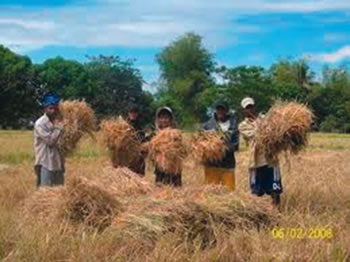In Asia Spiritual Vitality Offers An Opportunity to the West
 By Regis Anouil M.E.P. and taken from “Missions Etrangeres de Paris” May 2014
By Regis Anouil M.E.P. and taken from “Missions Etrangeres de Paris” May 2014
Vocations are blossoming, even if Catholics often remain very much minority groups. However, priests and religious who have come from the East are spreading their fervour to congregations of the Old Europe.
When the cold statistical reality is closely examined, the future of the Church is seen to be inAsia.
That part of the world, in which are found only 12% of the planet’s Catholics, provides, each year, a quarter of the newly ordained priests. Even very dynamic Africa doesn’t do as well, with “only” a fifth of the new priests of the universal Church. This growth is found everywhere in the Church in Asia, whether it is novices who will become religious sisters, or seminarians who are preparing to become diocesan priests or to pronounce religious vows. At the time when a Jesuit Pope sits on the throne of Peter, one statistic strikes the imagination: of the nearly 20,000 members of the Society of Jesus throughout the world, 4,034 are in the Indian sub-continent. If the Jesuits of Asia –Pacific are added to that, it is found that almost 30% of the total membership of the Society are here. And the coming years will only strengthen that tendency: in 2,012, out of 2,896 scholastics being formed throughout the world, 1,389, almost half, are in Asia.
In 2007 a symposium on vocations organised by the Federation of Episcopal Conferences of Asia (FABC) drew, however, no advantage from these statistics, which would be the envy of European seminaries. Gathered at Bangkok, the organisers of the symposium noted that “these global statistics” came up against “a major reality – the shortage of priests.” In a part of the world where Catholics represent no more than 3% of the population, “we are a small minority, truly the little flock that is referred to in the Gospel”, wrote these Catholic leaders, citing the parable of the abundant harvest and the few workers. The challenge of the minority situation “takes on a greater meaning when the present context which is ours in Asia is considered, and its impact on families and vocations, that is, massive poverty, a multicultural and plurireligious environment which is the source of frequent tensions, and the subtle, but certain intrusion of a materialistic and secularised culture into the profoundly religious cultures of Asia.” In the concluding document of the symposium they affirmed: “We must not dream so much of vocations in great numbers, but of people who can form a creative minority truly ready to answer a call to radicality and sacrifice.”
In the immensity of Asia, it is hard to find points in common between Churches which live in very different contexts. What indeed is comparable between the tiny Church of Cambodia, coming to rebirth [after the slaughter of most of its leaders by the Khmer Rouge government in the 1970s – translator’s note] where five young men are studying for the priesthood, and the Church in its neighbour, Vietnam, where the bishops are erecting a quasi-moratorium on recruitment by imposing selective examinations on entry to the seminary? However some trends are emerging, and some allow it to be thought that the growth of vocations in Asia could be for a certain time only. For several years already, the regional seminary of Sheshan, near Shanghai, in China, has not received any candidates from the Catholic communities in the metropolis; the vocations are coming from the surrounding countryside or the neighbouring provinces. The growing urbanisation of the population goes along with materialism and secularisation.
An emeritus professor at St Peter’s Seminary at Bangalore in India, Lucien Legrand, an MEP priest, comes to the same conclusion: “The seminaries are full, the religious congregations continue to draw from this generous spring, but it seems that the flood is beginning to slow. At Bangalore, last year, there were only 29 entrants in their first year at the seminary, while six years ago there were nearly 50.” A higher standard of living? Family planning which, generally, reduces family size? The French missionary, who has been in India more than 50 years, refuses to come to a hasty conclusion. “Curiously, “ he says, “this decrease is less obvious in the urban dioceses where the level of development is higher, as in Bombay (Mumbai), Mangalore or Bangalore” he emphasises, refuting the idea that priestly or religious vocations may be used by some as a way of rising in social status. More certainly, the continuing investment by local Churches in education, in disadvantaged rural areas or in the midst of social elites, is opening up an important potential source of vocations.
For certain international congregations, the swing towards Asia is already a reality. Having come into existence in Europe, notably during the great re-evangelisation of the nineteenth century, they have flourished in Africa and Asia and, in face of the drying up of European vocations, today see themselves renewed by their members who have come from “the South”. Sister Anne-Marie Berckmans is an assistant to the Superior-general of the Sisters of Charity of Jesus and Mary, a Belgian congregation founded in 1803, and whose 478 European members today are almost all aged 60 or more. In 2003, their bicentenary, it was obvious to them that “the end was near”, that the congregation “had done its time”, and that it should close down. That was without taking into account the 312 Africans and the 583 Asians who had joined the congregation. In 2005 an Indian woman, Sister Chennakadan, was elected superior – general. “She knew how to renew us, by a return to our founder’s (Fr Peter Triest , 1760- 1836) intuition, closeness to the poor,” says Sister Anne-Marie. “Before the general chapter of 2011 met, she asked all the delegates to spend a week in contact with the poorest people. That brought about a real change, by re-centring us on greater simplicity based on a greater understanding of the gospel.”
To the extent that the provinces of Asia open themselves up to the universal service of the mission, “it can be seen that the Jesuits of the South discuss things among themselves, without going through Europe any more”, notes Arnaud de Rolland, for whom this evolution need not be a reason for worry in the West. “Our spiritual tradition is a treasure to be passed on and it is certainly that way in which Europe will renew its contribution to the world-wide Society”, says the man who was director of the Manresa Centre at Clamart.
(Translated by Fr Brian Quin, s.m.)


 Entries(RSS)
Entries(RSS)